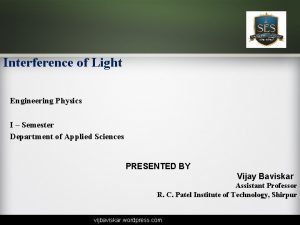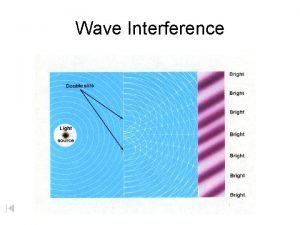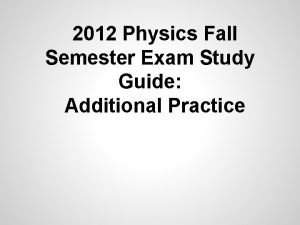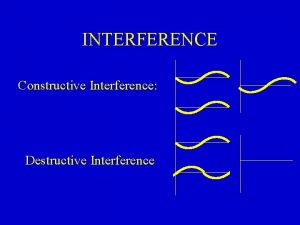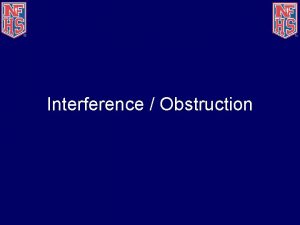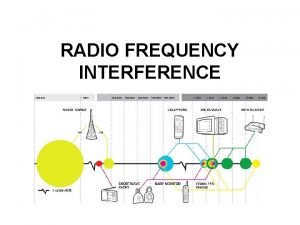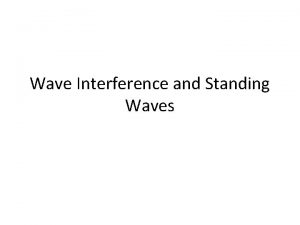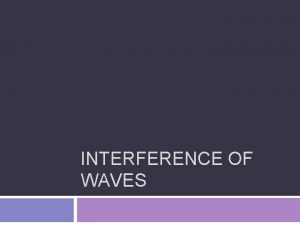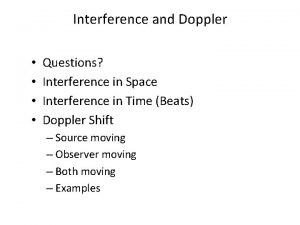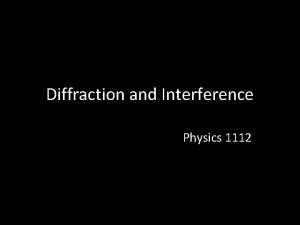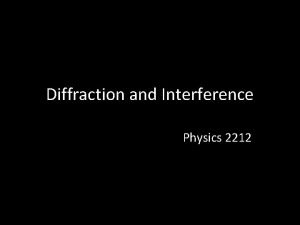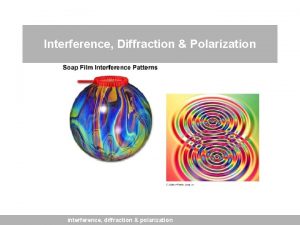Interference of Light Engineering Physics I Semester Department












- Slides: 12

Interference of Light Engineering Physics I – Semester Department of Applied Sciences PRESENTED BY Vijay Baviskar Assistant Professor R. C. Patel Institute of Technology, Shirpur vijbaviskar. wordpress. com

COURSE OBJECTIVE • Student will able to define Interference. • Student will able to differentiate types of interference. • Student will able to describe the working of Michelson’s Interferometer. • Student will able to calculate different parameter of light by using Michelson’s Interferometer.

COURSE OUTLINE • Interference. • Types of Interference. • Michelson’s Interferometer. • Applications of Michelson’s Interferometer.

Introduction v Interference: The modification of intensity due to superposition of two or more light waves is called interference. v Superposition: When two or more waves arrive at a point in a space simultaneously, then their resultant intensity at that point is always equal to the vector sum of their individual intensities. v Conditions of interference: ü At least two waves are required. ü The light waves are identical (monochromatic) and coherent. ü The distance between two sources must be small. ü The distance between sources and screen should be large. 4

Types of interference Constructive Interference : When two or more waves arrive at a point are in phase with each other then their resultant intensity increases and gives out bright band is called constructive interference. Destructive Interference : When two or more waves arrive at a point are out of phase with each other then their resultant intensity decreases or zero and gives out dark band is called constructive interference. 5

Constructive Interference First wave of wavelength = 1 = Black Color Particle displaced due to wave of wavelength 1 Particle displaced due to wave of wavelength 2 a Second wave of wavelength = 2 = Red Color Displacement of Particle due to wave of wavelength 1 = a 2 = a Resultant displacement of Particle due to both waves of wavelength 1 & 2 = a + a = 2 a Here amplitudes of both waves are added , It is called as Enhancement of amplitudes In another situation amplitudes of both waves are Cancelled

Destructive Interference First wave of wavelength = 1 = Black Color Particle displaced due to wave of wavelength 1 Particle displaced due to wave of wavelength 2 a a Second wave of wavelength = 2 = Red Color Displacement of Particle due to wave of wavelength 1 = a 2 = a Resultant displacement of Particle due to both waves of wavelength 1 & 2 = a - a = 0

Michelson’s Interferometer: Constriction: Working: Fig. Michelson’s Interferometer 9

M 1 C G M 2 Fig. Michelson’s Interferometer

Nature of Fringes v Circular Fringes: Mirror M 1 and M 2’ Must be parallel to each other. As shown in fig. (d) v Straight Fringes: Mirror M 1 intersect M 2’. As shown in fig. (b) v Curved Fringes: Mirror M 1 and M 2’ are inclined to each other. As shown in fig. (a) & (c). Fig. Nature of Fringes 11

Application of Michelson’s Interferometer Ø Ø Measurement of wavelength. Thickness and refractive index of transparent plate. Measure speed of light. The difference in the wavelength of two waves, i. e. resolution of spectral lines. 12

Thank You 2/26/2021 S. P. Shukla 13
 Interference of light engineering physics
Interference of light engineering physics Proactive interference
Proactive interference Retroactive vs proactive interference
Retroactive vs proactive interference Light light light chapter 23
Light light light chapter 23 Into the light chapter 22
Into the light chapter 22 Light light light chapter 22
Light light light chapter 22 Interference of light
Interference of light Honors physics semester 2 review
Honors physics semester 2 review Physics semester 1 final exam study guide answers
Physics semester 1 final exam study guide answers Physics fall semester review answers
Physics fall semester review answers Princeton physics department
Princeton physics department Physics 121 njit
Physics 121 njit Sputonik v
Sputonik v
